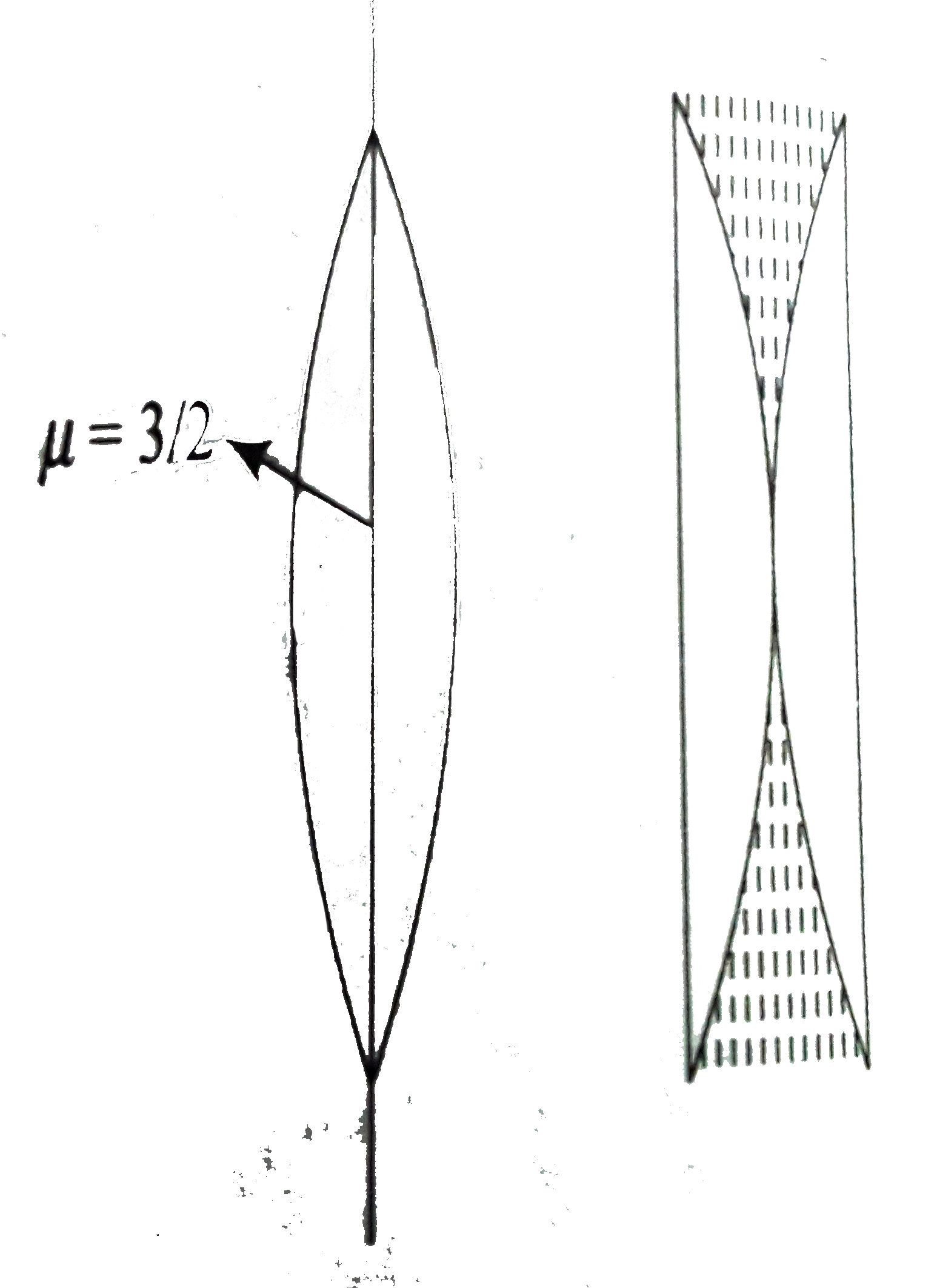An equiconvex lens of glass (μg=1.5) of focal length 10 cm is silvered on one side. It will behave like a
concave mirror of focal length 10 cm
convex mirror of focal length 5.0 cm
concave mirror of focal length 2.5 cm
convex mirror of focal length 20cm
The correct Answer is:C
To solve the problem of determining how an equiconvex lens of glass (with a refractive index μg=1.5 and a focal length of 10 cm) behaves when silvered on one side, we can follow these steps:
Step 1: Understand the System
The given system consists of an equiconvex lens that is silvered on one side. When one side of the lens is silvered, it behaves like a combination of a lens and a mirror.
Step 2: Identify the Focal Length of the Lens
The focal length of the equiconvex lens is given as fL=10cm.
Step 3: Calculate the Focal Length of the Mirror
For a mirror, the focal length fM is related to the radius of curvature R by the formula:
fM=R2
To find R, we can use the lens maker's formula for the lens:
1fL=(μ−1)(1R1−1R2)
For an equiconvex lens, R1=R and R2=−R. Thus:
1fL=(1.5−1)(1R−(−1R))=0.5×2R=1R
From this, we can find R:
R=fL=10cm
Now, substituting R into the mirror focal length formula:
fM=102=5cm
Step 4: Combine the Focal Lengths
When the lens is silvered on one side, the effective focal length fcomb of the combination can be calculated using the formula:
1fcomb=1fL+1fM
Substituting the values:
1fcomb=110+15=110+210=310
Thus, the focal length of the combination is:
fcomb=103≈3.33cm
Step 5: Determine the Sign of the Focal Length
Since the rays converge in front of the lens-mirror combination, the focal length is considered negative:
fcomb=−3.33cm
Conclusion
The system behaves like a concave mirror with a focal length of approximately −3.33cm.
The given system consists of an equiconvex lens that is silvered on one side. When one side of the lens is silvered, it behaves like a combination of a lens and a mirror.
The focal length of the equiconvex lens is given as fL=10cm.
For a mirror, the focal length fM is related to the radius of curvature R by the formula:
fM=R2
To find R, we can use the lens maker's formula for the lens:
1fL=(μ−1)(1R1−1R2)
For an equiconvex lens, R1=R and R2=−R. Thus:
1fL=(1.5−1)(1R−(−1R))=0.5×2R=1R
From this, we can find R:
R=fL=10cm
Now, substituting R into the mirror focal length formula:
fM=102=5cm
When the lens is silvered on one side, the effective focal length fcomb of the combination can be calculated using the formula:
1fcomb=1fL+1fM
Substituting the values:
1fcomb=110+15=110+210=310
Thus, the focal length of the combination is:
fcomb=103≈3.33cm
Since the rays converge in front of the lens-mirror combination, the focal length is considered negative:
fcomb=−3.33cm
The system behaves like a concave mirror with a focal length of approximately −3.33cm.
Topper's Solved these Questions
- RAY OPTICSBook:DC PANDEY ENGLISHChapter:RAY OPTICSExercise:A. Only one option is correct (JEE Advance)
Explore 73 Videos
- RAY OPTICSBook:DC PANDEY ENGLISHChapter:RAY OPTICSExercise:B. More than one option is correct
Explore 20 Videos
- PROPERTIES OF MATTERBook:DC PANDEY ENGLISHChapter:PROPERTIES OF MATTERExercise:Integer
Explore 8 Videos
- ROTATIONBook:DC PANDEY ENGLISHChapter:ROTATIONExercise:(C) Chapter Exercises
Explore 39 Videos
Similar Questions
A thin equiconvex lens (μ=3/2) of focal length 10cm is cut and separated and a material of refractive index 3 is filled between them. What is the focal length of the combination?

View SolutionOne face of an equiconvex lens of focal length 60cm made of glass (μ=1.5) is silvered. Does it behave like a convex mirror or concave mirror? Determine its focal length.
View Solution
Knowledge Check
A point object O is placed at a distance of 20 cm is front of a equiconvex lens (.aμg=1.5) of focal length 10 cm. The lens is placed on a liquid of refractive index 2 as shown in figure. Image will be formed at a distance h from lens the value of h is
 A5 cmB10 cmC20 cmD40 cm
A5 cmB10 cmC20 cmD40 cm
The rear face of an equiconvex lens of focal length 30 cm is silvered that if behave like a concave mirror The focal length of mirror is [μLens= 3/2]
View SolutionA plano-convex lens when silvered ono the plane side behaves like a concave mirror of focal length 60 cm. However, when silvered on the convex side, it behaves like a concave mirror of focal length 20cm. Then, the refractive index of the lens is
View SolutionA plano-convex lens when silvered in the plane side behaves like a concave mirror of focal length 30 cm. However, when silvered on the convex side it behaves like concave mirror of focal length 10 cm. Then the refractive index of its material will be:
View SolutionA convex glass lens (μg=1.5) has a focal length of 8 cm when placed in air. What is the focal length of the lens when it is immersed in water ?
(μω=43)
View SolutionA concave lens with unequal radii of curvature made of glass (μg=1.5) has a focal length of 40cm. If it is immersed in a liquid of refractive index μ1=2, then
View SolutionA point object is placed at 30 cm from a convex glass lens (μg=32) of focal length 20 cm. The final image of object will be formed at infinity if
View SolutionAn equiconvex lens of glass of focal length 0.1 metre is cut along a plane perpendicular to principle axis into two equal parts. The ratio of focal length of new lenses formed is:
View Solution